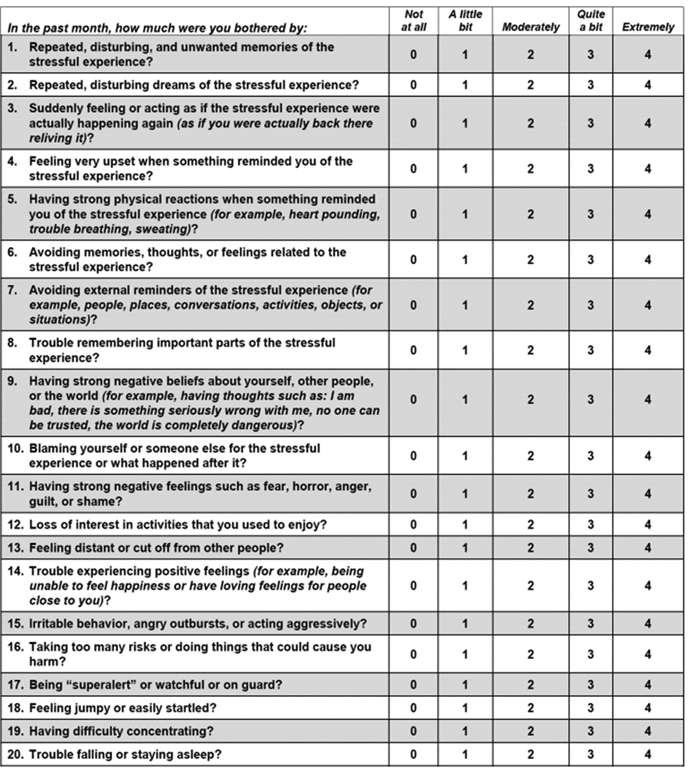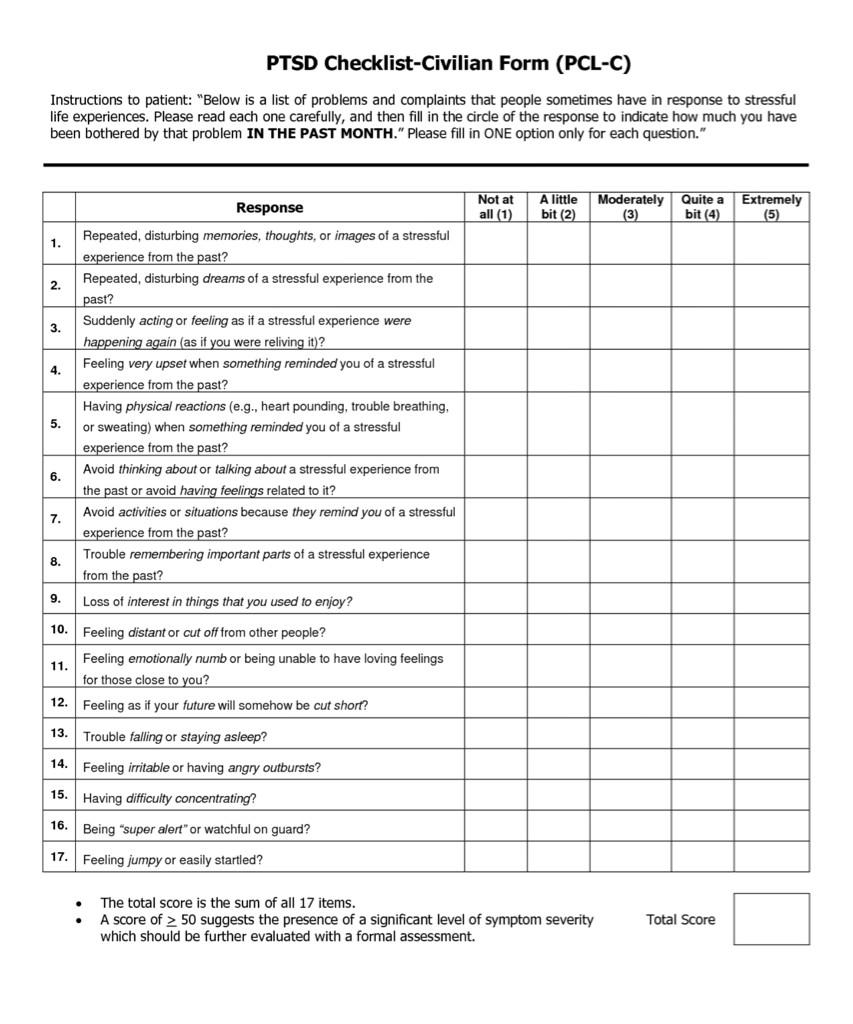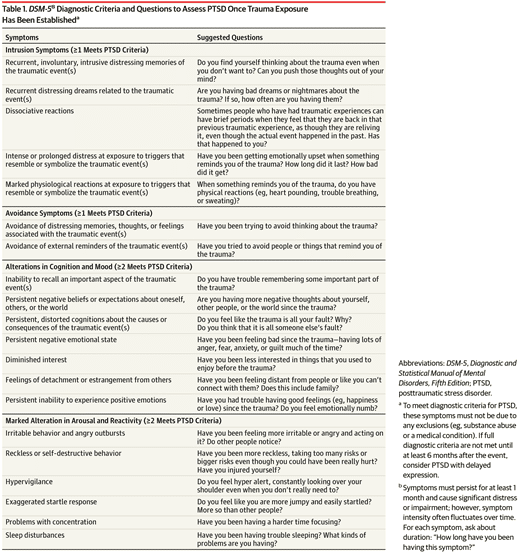Evaluation Of Our Findings
The decision to drop criterion A2 in DSM-5 was supported in our study. Atotal of 20% of those who would otherwise have met criteria for DSM-IVfailed to get a diagnosis because they did not meet A2 criteria. Apart fromthe difference caused by A2, the current prevalence identified by DSM-5compared with DSM-IV was lower and this was largely explained by someparticipants failing to meet the active avoidance cluster. This isconsistent with the findings of Forbes et al,Reference Forbes, Fletcher, Lockwood, O’Donnell, Creamer and Bryant20 and congruent with the assumption that active avoidance is a corepart of this disorder.
The final aim of this study was to explore the relationship of PTSD withfunctional outcomes under the different diagnostic algorithms. It isreasonable to assume that a disorder only reaches clinical significance whenit impairs social or occupational functioning, or disrupts quality of life.Although ICD-11 showed particularly low sensitivity with high disability/lowquality of life, there was surprisingly little difference across the variousalgorithms in terms of overall diagnostic accuracy . If therefore we wish to identify thosewhose mental health problems warrant intervention, there may be little tochoose between the ICD and DSM revisions for PTSD. It is noted however, thatthose meeting ICD-11 only did have asignificantly lower psychological quality of life, which adds support forthis version of the criteria.
Changes Between The Dsm
- Persistent and exaggerated negative beliefs or expectations about oneself, others, or the world
- erroneous self-blame or blaming others for the trauma
- negative mood states
- reckless and maladaptive behavior, e.g. example reckless driving
- the irritability symptoms has criterion been changed to aggressive behavior, which includes verbal aggression but does not refer to violence :272-274
- illusions and hallucinations have been removed from the examples of trauma symptoms listed in one criteria
- the DSM-IV delayed onset specifier has been reworded to delayed expression this is used when symptoms were delayed for at least 6 months after the trauma. Some PTSD symptoms may begin immediately after the trauma. :273-274
A sense of a foreshortened future,PTSD dissociative sub-typespecifier
What Is The Dsm
Used to diagnose mental disorders, DSM stands for Diagnostic and Statistical Manual of Mental Disorders. It’s a book that is basically like an encyclopedia of psychological disorders. The book originally was published in 1952, but has been updated multiple times resulting in the current edition of the DSM-5.
The DSM was created by over a hundred and sixty clinicians and researchers from all over the globe. The purpose of creating the DSM is to provide a handbook for mental health professionals and other healthcare workers.
The DSM includes lists of symptoms and criteria that they can use in order to diagnose patients with mental disorders. This guidebook helps to make diagnosis and communication about mental illness more consistent.
Over the years, the book has continued to be updated and revised as there is research consistently happening on an ongoing basis around mental health disorders. These revisions help to keep the book accurate for our current day in order to help the most amounts of people. The most recent additions to the book were made in order to include symptoms that people were commonly experiencing with mental disorders such as PTSD, but we’re not already included in the book.
Recommended Reading: Is Stuttering A Disability Under The Ada
Resources And Assistance With Va Claims
Veterans have played an outsized role in spreading awareness of PTSD, especially following the recent wars in Afghanistan in Iraq. The disorder is better understood now than it ever has been in the past, and because veterans have a higher likelihood of experiencing traumatic events, we encourage any who experience the diagnostic criteria above to seek professional treatment. VA provides extensive services to help veterans cope with this disorder.
Should you have any difficult obtaining the level of treatment you need for PTSD, and need our help to increase your disability rating for PTSD, you can reach us at 844-VET-LAWS or fill out our online form.
History Of Complex Ptsd Diagnosis

In 1988, Dr. Judith Herman of Harvard University suggested that a new diagnosis, complex PTSD, was needed to describe the symptoms of long-term trauma . Such symptoms include, according to her formulation:
- Behavioral difficulties
- Emotional difficulties
- Cognitive difficulties
- Interpersonal difficulties
In This Article
The World Health Organization, in its 11th revision of the International Disease Classification , has taken a very different approach. The PTSD diagnosis in ICD-11 consists of only the following symptoms: re-experiencing the traumatic event avoidance of thoughts, memories, activities, etc. that serve as reminders of the event and, persistent perceptions of heightened current threat. Individuals are considered to have complex PTSD if they meet these symptoms and in addition endorse 1) affect dysregulation, 2) negative self-concept, and 3) disturbed relationships . On the other hand, in the DSM-5, these symptoms fall within PTSD criteria so would not warrant an additional diagnosis other than PTSD.
Don’t Miss: What Are Discriminatory Actions In Disability
Suicide Risk And Comorbidities
Traumatic events increase a persons suicide risk, and PTSD is strongly associated with suicidal ideation and suicidal attempts.
PTSD is also linked to other mental disorders. According to DSM-5, those with PTSD are 80% more likely than those without it to have symptoms that meet the diagnostic criteria for at least one other mental disorder, such as depressive, bipolar, anxiety, or substance abuse disorders. Although females are at greater risk of PTSD, males diagnosed with PTSD are more likely to have a comorbidity. Among Afghanistan and Iraq veterans, its been found that the co-occurrence of PTSD and a mild traumatic brain injury was 48%.
Comparison Of Prevalence Rates Across Dsm
PTSD prevalence rates were not statistically significantly different in comparisons of the DSM-5 and ICD-11 in the full sample , and agreement was 89.3% overall. PTSD prevalence rates were also not significantly different within sub-analyses and were as follows: assaultive traumas non-assaultive traumas men women Caucasians racial minorities . Notably, the rate of PTSD was higher for the DSM-5 than the ICD-11 across all groups.
Recommended Reading: Emergency Housing For Disabled People
What Additional Problems Are Associated With Chronic Trauma
In addition to PTSD, chronic trauma is sometimes associated with other comorbidities including substance use, mood disorders, and personality disorders. A thorough assessment using validated instruments is critical to creating a comprehensive and effective treatment plan.
An individual who experienced a prolonged period of chronic victimization and total control by another may also experience difficulties in the following areas:
- Emotional regulation. May include persistent sadness, suicidal thoughts, explosive anger, or inhibited anger.
- Consciousness. Includes forgetting traumatic events, reliving traumatic events, or having episodes in which one feels detached from one’s mental processes or body .
- Self-perception. May include helplessness, shame, guilt, stigma, and a sense of being completely different from other human beings.
- Distorted perceptions of the perpetrator. Examples include attributing total power to the perpetrator, becoming preoccupied with the relationship to the perpetrator, or preoccupied with revenge.
- Relations with others. Examples include isolation, distrust, or a repeated search for a rescuer.
- One’s system of meanings. May include a loss of sustaining faith or a sense of hopelessness and despair.
Ptsd Illusions And Hallucinations
hearing voicesParanoia
“Flashbacks in Posttraumatic Stress Disorder must be distinguished from illusions, hallucinations, and other perceptual disturbances that may occur in Schizophrenia, other Psychotic Disorders, Mood Disorder with Psychotic features, a delirium, Substance-Induced Disorders, and Psychotic Disorders Due to a General Medical Condition.” :467
Don’t Miss: How Much Does Mental Health Disability Pay
Exposure To Ptes And Probable Ptsd Diagnosis
Responses on the HTQ revealed that participants in this sample had been exposed to multiple types of PTEs. On average, participants had experienced 5.68 types of PTEs, with the vast majority reporting exposure to at least one type of PTE. The frequency of exposure to PTEs are summarised in Table . Participants most commonly experienced lack of food or water and being close to death . Additionally, more than one third of the sample had experienced imprisonment and/or torture , and just under one fifth were survivors of rape or sexual abuse . A total of 51 participants were identified as having a probable diagnosis of PTSD.
Table 3 Frequency of Exposure to Potentially Traumatic Events
What Are The Dsm
Trauma impacts everyone differently, so no two cases will look exactly alike. Still, there are some common symptoms for example, most people experience intrusive memories.
The Diagnostic and Statistical Manual of Mental Disorders, 5th edition, text revision , the manual licensed clinicians use to consider and diagnose mental health disorders, offers some guidance.
To receive a diagnosis of PTSD, you must have experienced a traumatic event such as a disaster, violence, accident, or other physically life threatening situation.
Also, your symptoms must be ongoing for at least a month. They also must interfere with multiple areas of your life, like your work, school, relationships, or home life.
Recommended Reading: Is Asperger’s A Disability Uk
Two Specifications Required For Diagnosing Ptsd:
- Dissociative Specification. In addition to meeting criteria for diagnosing PTSD, an individual experiences high levels of either of the following in reaction to trauma-related stimuli:
- Depersonalization. Experience of being an outside observer of or detached from oneself .
- Derealization. Experience of unreality, distance, or distortion .
What Helps With Ptsd And Complex Ptsd

There are two particular interventions that are generally recommended if a child or young person has a diagnosis of PTSD : Trauma-focused Cognitive Behavioural Therapy and Eye Movement Desensitisation and Reprocessing . Research has consistently found that these are effective for PTSD in children and young people. However that does not mean that they will work for all children with PTSD and some research indicates that other approaches might also be effective .
There is much less research evidence about what interventions are effective for Complex PTSD, however there is emerging evidence that what works for PTSD is likely to be effective for Complex PTSD , but it may require more sessions and more focus on developing a trusting relationship .
Don’t Miss: Best Service Dog Breeds For Ptsd
S Of The Brain Involved In Ptsd
Brain scans have shown what many scientists suspected for many years: the brains of those afflicted with posttraumatic stress disorder symptoms operate differently than those without the condition. A few regions involved in PTSD have been identified using functional MRI scans and other forms of brain imaging technology.
The amygdala, a small area of the limbic system which is responsible for processing emotions, is involved in our perception of fear. Brain scans of people with PTSD show abnormally high activity in the amygdala in relation to triggering stimulus. The hippocampus, another area which is involved in memory processing, also shows high reactivity.
These areas and others in the brain become conditioned to interpret environmental cues that the brain has connected to the past trauma. Triggers can be anything even loosely associated with the event, such as a song, a scent, a name, or a place. You may not be aware of all of your potential triggers until they set off your symptoms.
Ptsd In Preschool Children
Infants and children aged six years old or younger can be diagnosed with PTSD, but young children’s thinking and ability to express themselves in words is limited. This means both their symptoms and diagnostic criteria are slightly different from those in adults or older children. Most of the research on Preschool PTSD involved three- to six-year-olds, with some studies also including younger children. Babies and toddlers can have PTSD: the minimum age for diagnosis is one year old.:272-274The criteria for Posttraumatic Stress Disorder for Children 6 Years and Younger are “developmentally sensitive”. Some of the changes from the main PTSD criteria include:
- constricted play is an example of “diminished interest in significant activities”
- social withdrawal or behavioral changes can indicate “feelings of detachment or estrangement.
- extreme temper tantrums are now included with “irritability or outbursts of anger”
- intrusive symptoms such as flashbacks and intrusive thoughts do not always manifest overt distress in preschool childrenScheeringa states that “while distressed reactions are common, parents also commonly reported no affect or what appeared to be excitement”
- fewer avoidance symptoms are included because avoidance is internalized, and harder to detect by observation, for example in pre-verbal children
Developmental Trauma Disorder
Read Also: What Illness Qualifies For Short Term Disability
Ptsd With Dissociative Features
- With dissociative symptoms . :272, :1145
- All the PTSD criteria are met
- “High levels of depersonalization or derealization” are also present
- Dissociative symptoms are not linked to substance use or another medical condition
- it is found in both children and adults
Criterion G: Functional Significance
The PTSD symptoms experienced by the person with the diagnosis must create distress or functional impairment in a persons life.
For example, a veteran who suffers from PTSD and currently works in an office setting may find that he has difficulty concentrating and is irritable toward his coworkers. These symptoms may harm his job performance. A college student who experienced sexual assault at a party may find that their friendships are affected by their negative affect, hypervigilance, and avoidance of other social events.
Read Also: How Much Does Disability Pay Per Month
Assessment In Ptsd Treatment
Assessment of PTSD can be conducted using a range of available instruments, each possessing varying strengths and weaknesses. Structured, standardized diagnostic interviews are considered the gold standard for assessing PTSD symptoms. However, because such structured interviews are time-consuming and must be administered by a trained clinician, it may not be feasible to administer them in every situation. Self-report measures of PTSD symptomatology can be used when time and resources are scarcer but they have their own limitations. Specifically, self-report instruments have fixed item content and rating scale formats, and their accuracy is contingent upon the patient understanding each item and answering truthfully.
After treatment, assessment of the symptoms that were targeted during treatment allows the clinician to determine the degree of symptom improvement by calculating reliable change and clinically significant change scores. Reliable change scores indicate the extent to which changes on scores of a particular measure are greater than the expected measurement error . Clinically, significant change scores indicate the extent to which the patients end state scores on a particular measure compare with scores observed in clinically meaningful comparison groups .
Criterion C: Avoidance Symptoms
The third criterion for a PTSD diagnosis is avoidance of reminders of the trauma.
This could be an avoidance of thoughts or feelings about the event or avoidance of trauma-related reminders altogether. A person who suffered sexual assault may display avoidance of thoughts and feelings of the assault and do their best to never think about the event.
Someone who witnessed a person drowning may avoid trauma-related reminders and stay away from pools or bodies of water, for example.
In the case of military veterans, they may avoid any depictions of violence to avoid reminders of their own trauma. For a diagnosis of PTSD, the presence of at least one of these symptoms is required.
Also Check: In-home Care For Veterans
Cognitive And Mood Alterations
Negative changes in cognitions and mood associated with the traumatic event, beginning or worsening after the traumatic event occurred, as evidenced by two of the following:
-
inability to remember an important aspect of the traumatic event
-
persistent and exaggerated negative beliefs or expectations about oneself, others, or the world
-
persistent, distorted cognitions about the cause or consequences of the traumatic event that lead the individual to blame himself/herself or others
-
persistent negative emotional state
-
feelings of detachment or estrangement from others
-
persistent inability to experience positive emotions
Criterion D: Physical Reactivity

The individual must also exhibit at least two of the following negative changes in mood or cognition.
- Cannot remember details about the event
- Persistent, negative beliefs about themselves, others, or the world as a whole
- Blaming oneself for the events occurrence
- Persistent negative emotional state, for example sad, angry, fearful
- Feeling detached from others
- Inability to experience positive emotions
Also Check: How To Apply For Disability In Ohio
Chronic And Severe Ptsd
This section refers to research from PTSD resulting from a single trauma caused by physical or sexual assault/rape, rather than multiple traumas, although severe and persistent PTSD can be caused by either.Chronic PTSDAcute PTSD
- Nowhere is safe
- I cannot rely on other people
- I canât trust my own judgments
- It was my fault
Severe PTSDmild, moderate or severe,
- sense of hopelessness
- emotional detachment
initial
- See also: Complex PTSD for PTSD from multiple in erpersonal traumas, including child abuse
- See also: Treatment for PTSD, which includes a medication overview
- See also: PCL-5 PTSD checklist test to help assess PTSD
Comparision With Findings From Other Studies
The diagnostic requirements for PTSD in DSM-5 and the proposed criteria forICD-11 have incorporated a number of modifications to their earliercounterpart classification systems. The only two studies to examine theprevalence rates of the DSM-5 criteria provide conflicting results. The first study used a large sample oftraumatic injury survivors but used only thosecriteria that are shared across both DSM-IV and DSM-5, focusing on theimpact of splitting Cluster C to specifically require active avoidance.Reference Forbes, Fletcher, Lockwood, O’Donnell, Creamer and Bryant20 The prevalence of PTSD reduced by 26% as a result of thismodification and theprevalence of comorbidity between PTSD and major depression was reduced. Thesecond study used a non-clinical university sample,Reference Elhai, Ford, Ruggiero and Frueh21 raising questions about the extent to which the findings maygeneralise to the broader trauma-exposed community. Nevertheless, that studyreported a small increase in prevalence with the revised criteria.
Don’t Miss: How To Help Ptsd Flashbacks
